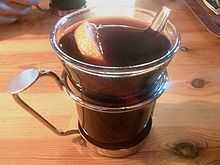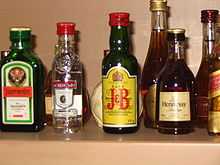Mulled wine

Mulled wine is a beverage usually made with red wine along with various mulling spices and raisins. It is served hot or warm and may be alcoholic or non-alcoholic.[1] It is a traditional drink during winter, especially around Christmas and Halloween.[2]
Port and claret are traditional choices for mulled wine, and are often combined.
Origins
Wine was first recorded as spiced and heated in Rome during the 2nd century.[3][4] The Romans travelled all across Europe, conquering much of it and trading with the rest. The legions brought wine and viticulture with them up to the Rhine and Danube rivers and to the Scottish border bringing their recipes with them.[5]
British mulled wine

Mulled wine is popular in the United Kingdom (and, more recently, in the United States[6]) at Christmas and throughout winter. One Victorian recipe was Smoking Bishop. Mulled cider and sometimes ale is also served, with a mulled apple juice as a non alcoholic alternative.
Another traditional recipe can be found in Mrs Beeton's Book of Household Management at paragraph 1961 on page 929 to 930 of the revised edition dated 1869:[7]
German and Austrian Glühwein
Glühwein (roughly, "glow-wine," from the hot irons once used for mulling) is popular in German-speaking countries and in the region of Alsace in France. It is a traditional beverage that is offered during the Christmas holidays. The oldest documented Glühwein tankard is attributed to Count John IV of Katzenelnbogen, a German nobleman who was the first grower of Riesling grapes. This gold-plated lockable silver tankard is dated to c. 1420.
Glühwein is usually prepared from red wine, heated and spiced with cinnamon sticks, cloves, star aniseed, citrus, sugar and at times vanilla pods. It is sometimes drunk mit Schuss (with a shot), which means that rum or some other liquor has been added. Fruit wines, such as blueberry wine and cherry wine, are occasionally used instead of grape wine in some parts of Germany. There is also a variation of Glühwein which is made with white wine. However, white Glühwein is less popular than its red counterpart.
Another popular variant of Glühwein in Germany is the Feuerzangenbowle. It shares the same recipe, but for this drink a rum-soaked sugarloaf is set on fire and allowed to drip into the wine.
Nordic glögg

Glögg, gløgg, and similar words are the terms used for mulled wine in the Nordic countries (sometimes misspelled as glog or glug). It is spelled gløgg in Norwegian and Danish, glögg in Swedish and Icelandic and glögi in Finnish and Estonian.
Non-alcoholic and alcoholic versions of glögg can be bought ready-made or prepared with fruit juices instead of wine. The main ingredients of alcoholic glögg are red wine, sugar, spices such as cinnamon, cardamom, ginger, cloves, and bitter orange, and optionally also stronger spirits such as vodka, akvavit, or brandy. Throughout Scandinavia, glögg spice extract and ready-mixed spices can be purchased in grocery stores. To prepare glögg, spices and/or spice extract are mixed into the wine, which is then heated to 60-70 °C. When preparing homemade glögg using spices, the hot mixture is allowed to infuse for at least an hour, often longer, and then reheated before serving. Ready-made wine glögg (and low- or non-alcoholic varieties) is normally sold at Systembolaget in Sweden, and in Alko in Finland, ready to heat and serve, and not in concentrate or extract form. Glögg is generally served with raisins, blanched almonds and Ginger biscuits (Ginger Snaps), and is a popular hot drink during the Christmas season.
In Sweden, ginger bread and lussebullar (also called lussekatter), a type of sweet bun with saffron and raisins, are typically served. It is also traditionally served at Julbord, the Christmas buffet. In Denmark, gløgg pairings typically include æbleskiver sprinkled with powdered sugar and accompanied with strawberry marmalade. In Norway, gløgg is paired with rice pudding (Norwegian: riskrem). In such cases, the word graut-/grøtfest is more precise, taking the name from the rice pudding which is served as a course. Typically, gløgg is drunk before eating the rice pudding, which is often served with cold, red cordial (saus).
Glögg recipes vary widely; variations with white wine or sweet wine such as Port or Madeira, or spirits such as brandy or whisky are also popular. Glögg can also be made without alcohol by replacing the wine with fruit or berry juices (often blackcurrant) or by boiling the glögg to evaporate the alcohol. Readymade non-alcoholic glögg is also available.[8] Glögg is similar in taste to modern Wassail or mulled cider.
Other countries

In the Netherlands, the drink is known as bisschopswijn (literally "bishop's wine"). Bisschopswijn is drunk during the Sinterklaas holidays. It uses oranges instead of lemons as an ingredient.
In France, vin chaud ("hot wine") typically consists of cheap red wine mixed with sugar, cinnamon, and lemon. It must not be too sweet.
In Bulgaria, it is called greyano vino (Bulgarian: греяно вино) ("heated wine"), and consists of red wine, honey and peppercorn. Sometimes apples and/or citrus fruits, such as lemon or oranges, can be added.
In Bosnia and Herzegovina, Croatia, Montenegro, Slovenia and Serbia, kuhano vino/kuvano vino/кувано вино ("cooked wine"), is made from red wine and various combinations of nutmeg, cloves, cinnamon, sugar and orange zest, often served with slices of orange or lemon.
In the south and southeast of Brazil, where a large amount of European descendants live, it is called vinho quente ("hot wine").[9][10] It is typically made with red wine, cinnamon sticks and cloves. It is served as part of the Festa Junina, celebrated during winter in the month of June.
In Chile it is called "vino navega'o" ('navegado' is considered a hypercorrection) ['sailor; navigator']. Navega'o is a hot drink made from red wine, orange peels, cinammon sticks, cloves, and sugar. Although being considered a southern Chile beverage, it is served throughout the country. Many people regard it as Winter drink. Saint John's Eve (Spanish tradition which replaced 'Wetripantru', the Mapuche New Year's Day that coincides with the Winter Solstice in the southern hemisphere—Midsummer in the northern hemisphere) on the evening of 23 June would be, for example, a good moment to drink 'navega'o'.
In the Czech Republic, mulled wine is called svařené víno ("boiled wine"), colloquially svařák.
In Hungary, forralt bor ("boiled wine") is typically made from the country's popular Egri Bikavér and spiced with cinnamon, sugar and cloves. Sometimes Amaretto is added for extra taste.
In Italy, mulled wine is typical in the northern part of the country and is called vin brulé ("burnt wine").
In Latvia, it is called karstvīns ("hot wine"). When out of wine, it is prepared using grape (or currant) juice and Riga Black Balsam.
In Republic of Macedonia, it is called vareno vino (Macedonian: варено вино, boiled wine) or greeno vino (Macedonian: греено вино, heated wine) and is usually served in late autumn or winter. It is made of red wine, usually from the Tikvesh region, combined with cinnamon and sugar or honey. The wine heated in a combination with pepper is used as a prevention from flu or cold.
In Moldova, the izvar is made from red wine with black pepper and honey.
In Poland, grzane wino ("heated wine") is very similar to the Czech variant, especially in the southern regions. There is also a similar method for preparing mulled beer or "grzane piwo" which is popular with Belgian beers because of the sweet flavor of that particular type of beer, which uses the same spices as mulled wine and is heated.
In Portugal, mainly in the Douro and Minho Provinces it is called vinho quente and made with Madeira wine and Port wine, in the Porto region Porto Quente is more popular.
In Romania, it is called vin fiert ("boiled wine"), and it is made using red wine, adding sugar, cinnamon, nutmeg, cloves, anise and orange zest. Everything is boiled and served hot.
In Russia, Глинтвейн ("Glintwein") is a popular drink during winters and has same recipe as the German Glühwein.
In Turkey, it is called Sıcak Şarap ("hot wine") and can be made using sweet red wine, adding sugar and fruits such as lemon and orange. (The classical sweet wine for this use used to be the now discontinued "Hoşbağ" brand of the former Turkish state monopoly "TEKEL".)
In Quebec, Canada, red wine is mixed with maple syrup and hard alcohol and heated. The drink is called Caribou and is very popular during the Quebec Winter Carnival.
See also
References
- ↑ Cloake, Felicity (9 December 2010). "How to make perfect mulled wine". The Guardian. Retrieved 5 February 2012.
- ↑ John, J. A Christmas Compendium. Continuum. p. 80. ISBN 0-8264-8749-1.
- ↑ Thomas Dudley Fosbroke (1835). A Treatise on the Arts, Manufactures, Manners, and Institutions of the Greeks and Romans. Longmans. p. 327.
- ↑ Titus Maccius Plautus (1829). M. Accii Plauti Comœdiæ. Cubrante et imprimente A. J. Valpy.
"Quos semper videas bibentes esse in Thermopolio: Ubi quid surripuere, operto capitulo calidum bibunt, Tristes atque ebrioli incedunt." In translation reads as "Those always seem to be drinking in the cafe where you have stolen , hiding in hot drink, always gloomy and tipsy." - Plautus, CURCULIONIS ACT. II. The reference to Plautus is given in "History of Rome, and of the Roman people: from its origin to the invasion of the barbarians", Victor Duruy, Estes and Lauriat, 1894, Page 400.
- ↑ J. Robinson (ed.)The Oxford Companion to WineThird Edition. Oxford University Press, 2006. 589–590
- ↑ http://freshnyc.com/blog/where-go-best-mulled-wine-or-spiced-wine-nyc
- ↑ "Mulled Wine". Wine Bottle Sizes. Retrieved 5 February 2012.
- ↑ "Glögg Alkoholfri: Mulled red wine, non-alcoholic". IKEA. Retrieved 2012-11-24.
- ↑ Hamilton, C. (2005). Brazil: A Culinary Journey. Hippocrene cookbook library. Hippocrene Books. p. 197. ISBN 978-0-7818-1080-7. Retrieved February 3, 2015.
- ↑ Herrera-Sobek, M. (2012). Celebrating Latino Folklore: An Encyclopedia of Cultural Traditions [3 volumes]. ABC-CLIO. p. 147. ISBN 978-0-313-34340-7. Retrieved February 3, 2015.
Bibliography
- NPR Staff. "Get into the Holiday Spirit with Scandinavian Glogg". All Things Considered. NPR. 22 December 2011.
External links
| Wikimedia Commons has media related to Mulled wine. |
| ||||||||||||||||||||||||||||||||||||||


